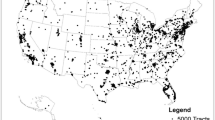Abstract
Empirical studies investigating urban sprawl and the determinants of city size with the Mills-Muth framework have struggled to find a reliable and ubiquitous proxy for the theoretical commuting costs variable. This study is the first to apply the Davidson-McKinnon non-nested specification test to address the long-standing issue in the literature of determining the best proxy measure for commuting costs. We employ this specification test to evaluate the three most widely available commuting costs measures from the literature: vehicle availability, public transit usage, and commuting speed. For a sample of all urbanized areas in 2000 and 2010, our results provide a degree of resolution. While we find for a pooled sample of all urbanized areas that commuting speed is the preferred proxy, subsample analysis reveals the prior result may be driven by larger urbanized areas spanning more than one county; commuting speed dominates the other proxies for these larger cities. Conversely, the sizes of single-county urbanized areas are explained by vehicle availability and transit usage, though neither of those proxy measures emerge as dominant, suggesting some unspecified measure may be better for these smaller cities.
Similar content being viewed by others
Data Availability
The data for this study is available at https://doi.org/10.17632/vczrf7g8sf.1
Code Availability
SAS and Stata code available upon request.
Notes
See, for example, Paulsen (2012), whose dissatisfaction with available commuting costs proxies prompts omission from the empirical models in that study.
The Census of Agriculture is not conducted in the same years as the Census of Population. We use 2002 and 2012 from the former, since they are the closest years to Census years 2000 and 2010, respectively.
Tract and UA centroid coordinates are from the Census Bureau Gazetteer files.
These results are available from the authors upon request.
Although the focus of this study in on commuting cost variables, we note in passing the negative and significant Income coefficient, which is a puzzling result that disagrees with the theory. Spivey (2008) and DiBartolomeo and Turnbull (forthcoming) also report a significantly negative income effect in several model specifications.
References
Brueckner, J. K., & Fansler, D. A. (1983). The Economics of Urban Sprawl: Theory and Evidence on the Spatial Sizes of Cities. Review of Economics and Statistics, 65(3), 479–482. https://doi.org/10.2307/1924193
Davidson, R., & MacKinnon, J. G. (1981). Several Tests for Model Specification in the Presence of Alternative Hypotheses. Econometrica, 49(3), 781–793. https://doi.org/10.2307/1911522
DiBartolomeo, J. A. (2020). Commuting Speed as a Proxy for the Value of Time. Economics Letters. 193. https://doi.org/10.1016/j.econlet.2020.109342
DiBartolomeo, J.A. and Turnbull, G.K. (forthcoming). On Urban Sprawl: Open City, Closed City or Does it Even Matter. Papers in Regional Science. https://doi.org/10.1111/pirs.12634
Fujita, M., & Ogawa, H. (1982). Multiple Equilibria and Structural Transition on Non-monocentric Urban Configurations. Regional Science and Urban Economics, 12, 161–196.
McGrath, D. T. (2005). More Evidence on the Spatial Scale of Cities. Journal of Urban Economics, 58, 1–10. https://doi.org/10.1016/j.jue.2005.01.003
Mills, E. S. (1967). An Aggregative Model of Resource Allocation in a Metropolitan Area. American Economic Review., 57(2), 197–210.
Muth, R. F. (1969). Cities and Housing. University of Chicago Press.
Oueslati, W., Alvanides, S., & Garrod, G. (2015). Determinants of Urban Sprawl in European Cities. Urban Studies., 52(9), 1594–1614. https://doi.org/10.1177/0042098015577773
Paulsen, K. (2012). Yet Even more Evidence on the Spatial Size of Cities: Urban Spatial Expansion in the U.S., 1980–2000. Regional Science and Urban Economics., 42, 561–568. https://doi.org/10.1016/j.regsciurbeco.2012.02.002
Song, Y., & Zenou, Y. (2006). Property Tax and Urban Sprawl: Theory and Implications for U.S. Cities. Journal of Urban Economics, 60, 519–534. https://doi.org/10.1016/j.jue.2006.05.001
Spivey, C. (2008). The Mills-Muth Model of Urban Spatial Structure: Surviving the Test of Time? Urban Studies, 42(2), 295–312. https://doi.org/10.1177/0042098007085964
Su, Q., & DeSalvo, J. S. (2008). The Effect of Transportation Subsidies on Urban Sprawl. Journal of Regional Science, 48, 567–594. https://doi.org/10.1111/j.1467-9787.2008.00564.x
Wheaton, W. C. (1974). A Comparative Static Analysis of Urban Spatial Structure. Journal of Economic Theory, 9, 223–237. https://doi.org/10.1016/0022-0531(74)90068-4
Author information
Authors and Affiliations
Corresponding author
Ethics declarations
Conflicts of Interest
Not applicable.
Additional information
Publisher's Note
Springer Nature remains neutral with regard to jurisdictional claims in published maps and institutional affiliations.
Rights and permissions
About this article
Cite this article
DiBartolomeo, J.A., Turnbull, G.K. Commuting Costs and Urban Sprawl: Which Proxy Measures Up?. J Real Estate Finan Econ 67, 375–387 (2023). https://doi.org/10.1007/s11146-021-09863-z
Accepted:
Published:
Issue Date:
DOI: https://doi.org/10.1007/s11146-021-09863-z




